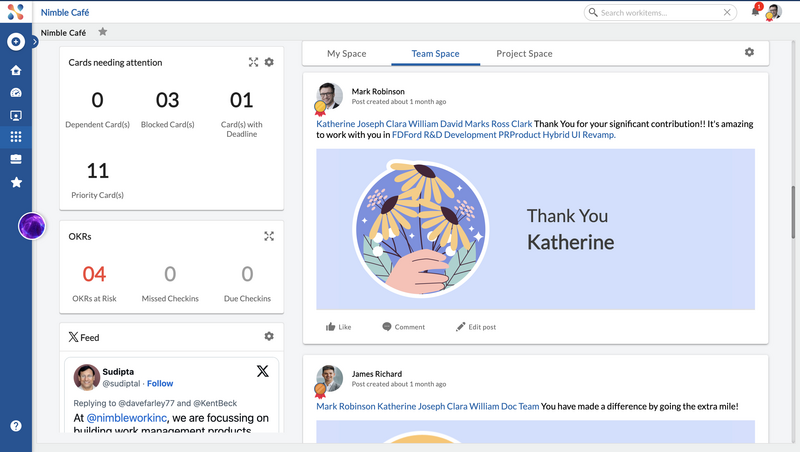In today’s fast-moving business world, a company’s success often depends on how well its different parts work together. Ideally, information should flow freely, and teams should work in harmony. But for many companies, the reality is far from this ideal.
Many businesses struggle with what we call “departmental silos.” These are invisible barriers that pop up between different departments like marketing, sales, engineering, and customer service. Each group ends up focused on its own goals and way of doing things, often at the expense of the bigger picture.
This separation isn’t just a small problem – it can really hold a company back. When departments don’t communicate well, projects can get delayed, product quality can suffer, and the company might fall behind its competitors.
In a time when businesses need to be quick and responsive to succeed, these internal divisions are a real problem. The solution? We need to break down these barriers. We need to create a workplace where different teams actually talk to each other, share ideas, and work towards common goals.
By bringing together the different skills and viewpoints from across the company, we can unlock our true potential. This is how we’ll grow and succeed in today’s complex business environment.
If the above act of bringing them together is not done, isolation leads to a cascade of problems:
- Miscommunication and Information Gaps: Critical information gets lost in the shuffle as it’s passed between departments with limited communication channels. Marketing teams might be unaware of critical product features, leading to inaccurate messaging. Sales teams could struggle to address customer concerns without clear insights from engineering.
- Handoff Bottlenecks: Projects stall when tasks are passed from one department to another without proper context or understanding. The receiving team spends valuable time deciphering the work done and catching up, leading to delays and frustration.
- Conflicting Priorities: Different departments often have separate goals and metrics. Marketing might prioritize brand awareness, while sales focus on immediate conversions. This misalignment can create friction within the team and hinder overall project progress.
- Lack of Transparency: When team members lack visibility into the work of other departments, it creates a sense of isolation and hinders collaboration. They might be unaware of challenges faced by other teams or miss opportunities for synergy.
These siloed structures prevent teams from leveraging the collective expertise and diverse perspectives needed for success in today’s competitive landscape. This is where the power of cross-functional teams comes in. By breaking down these barriers and fostering collaboration, companies can unlock a new level of efficiency and innovation.
What are Cross-Functional Teams?
Cross-functional teams bring together diverse expertise from various departments or disciplines within an organization to collaborate on specific projects or goals. This blending of skills and perspectives enhances innovation and problem-solving, as team members bring unique insights that might not arise in siloed departments.
However, managing cross-functional teams isn’t without its challenges. One common issue is communication barriers due to different jargon and priorities across departments. This can lead to misunderstandings and delays in decision-making. Another challenge is conflicting goals and priorities among team members, stemming from their different functional backgrounds.
To address these challenges, effective leadership and clear communication are paramount. Leaders must foster a culture of open dialogue, ensuring that all team members understand each other’s perspectives and goals. Regular meetings and updates can help synchronize efforts and align everyone towards a common objective. Additionally, establishing clear roles and responsibilities can minimize conflicts and ensure accountability.
In essence, while cross-functional teams offer immense potential for innovation and synergy, proactive management and communication strategies are crucial to harnessing their full potential and overcoming inherent challenges.
The Power of Cross-Functional Teams for Success of Projects
Cross-functional teams bring together individuals from various departments, like marketing, sales, engineering, and customer success, to work towards a common goal. This diverse group fosters a holistic understanding of the project, breaking down communication barriers and accelerating decision-making.
Here’s how cross-functional teams benefit :
- Improved Communication and Alignment: With representatives from each department at the table, everyone stays informed and aligned on project priorities. This reduces confusion and ensures everyone is working towards the same goal.
- Enhanced Efficiency: Cross-functional teams eliminate the inefficiencies of departmental handoffs. Team members can anticipate and address potential roadblocks early on, preventing delays and streamlining project execution.
- Greater Innovation: Diversity of perspectives leads to a richer pool of ideas. Cross-functional teams are more likely to come up with creative solutions and innovative approaches to challenges.
- Faster Time-to-Market: By streamlining communication and collaboration, cross-functional teams can significantly reduce time wasted on internal discussions and approvals. This translates to quicker project completion and faster time-to-market for your offering.
Simple Steps to Building a High-Performing Cross-Functional Team
Now that we understand the power of cross-functional teams and the challenges they address, let’s dive into four simple steps to build a high-performing team for your company:
Step 1: Assemble the Right Team with Diverse Skills
The first step involves selecting the right individuals to form your cross-functional team. Look for team members with the following qualities:
- Departmental Expertise: Include representatives from each relevant department who possess in-depth knowledge of their specific area.
- Strong Communication Skills: Effective communication is crucial for smooth collaboration. Choose team members who can articulate their ideas clearly and actively listen to others.
- Problem-Solving Skills: Look for individuals who can think critically, identify potential roadblocks, and work together to find solutions.
- Openness to New Ideas: A willingness to embrace diverse perspectives and learn from others is vital for fostering a strong team dynamic.
Project management tools such as Nimble, through their People Management capability offer features like skills matrices to help identify individuals with the necessary expertise for your project. Additionally, built-in communication tools based on the Humanising Work theme can help facilitate team introductions and early collaboration.
Step 2: Define Clear Goals and Objectives
Once your team is assembled, it’s crucial to establish a clear vision and define specific, measurable, achievable, relevant, and time-bound (SMART) goals for the project. Ensure everyone understands these goals and their individual roles in achieving them.
Being a Project management tool, Nimble has an OKR module that offers features like goal-setting functionalities at strategy level and connecting it to the execution through Key Results (KR’s) and Sub Key Results (Sub KR’s) at task level. These tools help visualize project milestones, assign ownership for tasks, and ensure everyone is aligned on priorities.
Step 3: Foster Open Communication and Collaboration
Cross-functional teams thrive on open communication and collaboration. Here are some ways to achieve this:
- Regular Team Meetings: Schedule regular meetings to discuss project progress, address any roadblocks, and brainstorm solutions collaboratively.
- Shared Documentation and Processes: Maintain centralized repositories for project documents, plans, and communication history. This ensures everyone has access to the latest information.
- Transparent Communication Channels: Utilize communication tools within your project management software and encourage ongoing dialogue between team members.
Leveraging Project Management Software: Nimble as a Project Management tool offers features like real-time chat, document sharing capabilities, and activity feeds.
Step 4: Promote Accountability and Recognition
A strong sense of accountability keeps team members motivated and invested in the project’s success. Here’s how to promote accountability:
- Clearly Defined Roles and Responsibilities: Ensure each team member understands their specific tasks and deliverables.
- Regular Performance Tracking: Utilize progress reports and performance dashboards within your project management software to track individual and team progress towards goals. This is enabled through a unique multiple progress viewing feature in Nimble.
- Recognition and Reward: Recognize and reward team members for their contributions and accomplishments.
Nimble offers task management features like clear assignment of responsibilities and deadlines. Additionally, it includes progress tracking dashboards and reporting functionalities. Along with this, Gamification feature and Nimble Cafe Features enables celebrating our team members achievement and contributions.
Functional vs Cross Functional Teams
Let’s try to understand the nuances of both these words to make the execution of the above steps more effective. Functional teams are structured around specific departments or disciplines, such as marketing, engineering, or finance. They consist of members who share similar skills, expertise, and objectives related to their department’s functions. These teams typically work within their own functional boundaries to achieve goals aligned with their department’s objectives.
In contrast, cross-functional teams are composed of members from different departments or disciplines who come together to work on a common project or objective. Unlike functional teams, which are department-centric, cross-functional teams are goal-centric. They are formed to leverage diverse perspectives and skills across departments to solve complex problems, drive innovation, or accomplish specific tasks that require input and expertise from multiple areas of the organization.
In summary, while functional teams focus on executing tasks within their specific departmental functions, cross-functional teams focus on achieving broader organizational goals by integrating diverse expertise and viewpoints across departments.Benefits of Using Project Management Software for Cross-Functional Teams
Now that we’ve explored the steps to build a high-performing cross-functional team, let’s delve into how your project management software can empower the teams to achieve even greater success. Here are some key benefits:
- Centralized Communication Platform: Your software acts as a central hub for all project communication, fostering transparency and keeping everyone informed. Features like real-time chat, discussion boards, and document sharing streamline information exchange and prevent miscommunication.
- Improved Task Management and Visibility: Assign tasks, track progress, and set deadlines within your project management software. This provides a clear view of project workflows and identifies potential bottlenecks early on. Team members can collaborate on tasks, share updates, and ensure seamless handoffs between departments.
- Enhanced Collaboration Tools: Project management platforms often offer features like whiteboards, kanban boards, and collaborative mind mapping tools. These tools facilitate brainstorming sessions, real-time problem-solving, and the development of shared strategies.
- Streamlined Reporting and Analytics: Gain valuable insights into project performance through insightful reports and dashboards. Track metrics like team productivity, resource allocation, and project progress to identify areas for improvement and make data-driven decisions.
Nimble Project Management Software: Built for High-Performing Teams
Nimble, Project/Work management software, empowers cross-functional teams with the tools and functionalities they need to collaborate seamlessly, achieve project goals efficiently, and deliver exceptional results.
Key Features for Cross-Functional Teams:
- “Thank-Talk-Celebrate” through Nimble Cafe where teams can collaborate and celebrate progress and contributions.
- Pull based Execution enabled through customisable Kanban columns and optimizing the outcomes through “Cards needing attention” features that ensures alignment and transparency among the team members.
Ready to experience the power of cross-functional teams and unlock the full potential of your teams? Sign up for a free trial of NimbleWork’s project management software today and see the difference collaboration makes.
Building high-performing cross-functional teams is key to achieving success in any project. By following the simple steps outlined above and leveraging the power of your project management software, you can empower your team to collaborate effectively, overcome challenges, and deliver exceptional results. Start Your Free Trial Today!









